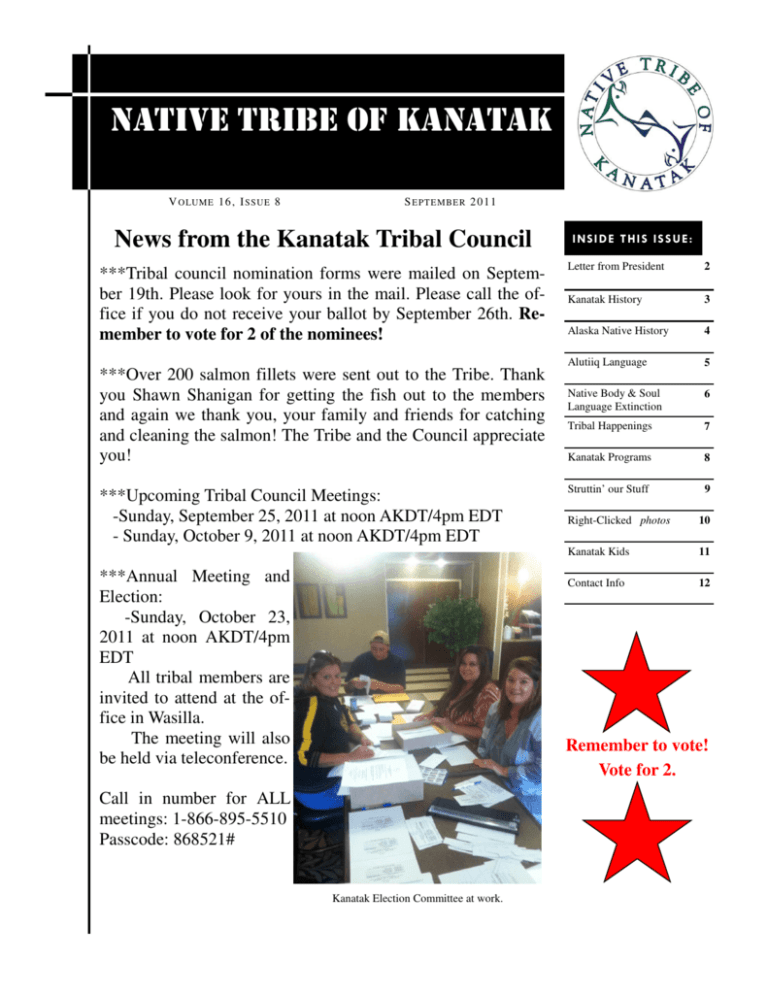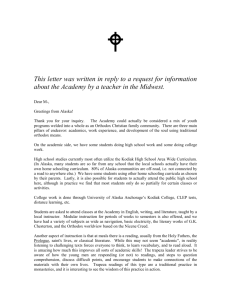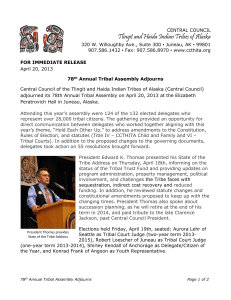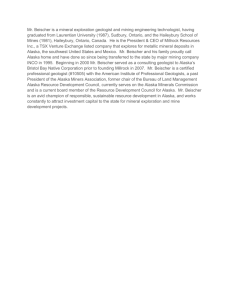The Alutiiq Language - Native Tribe of Kanatak
advertisement

!" #$%&##'%()&'
!"#$%&'#($)&'*+',"!"#",!
V O LUME 1 6 , I SSUE 8
S E PT E MBE R 2 0 1 1
News from the Kanatak Tribal Council
***Tribal council nomination forms were mailed on September 19th. Please look for yours in the mail. Please call the office if you do not receive your ballot by September 26th. Remember to vote for 2 of the nominees!
***Over 200 salmon fillets were sent out to the Tribe. Thank
you Shawn Shanigan for getting the fish out to the members
and again we thank you, your family and friends for catching
and cleaning the salmon! The Tribe and the Council appreciate
you!
***Upcoming Tribal Council Meetings:
-Sunday, September 25, 2011 at noon AKDT/4pm EDT
- Sunday, October 9, 2011 at noon AKDT/4pm EDT
***Annual Meeting and
Election:
-Sunday, October 23,
2011 at noon AKDT/4pm
EDT
All tribal members are
invited to attend at the office in Wasilla.
The meeting will also
be held via teleconference.
! " # ! $ % &' ( ! # &! # # ) % * &
Letter from President
2
Kanatak History
3
Alaska Native History
4
Alutiiq Language
5
Native Body & Soul
Language Extinction
6
Tribal Happenings
7
Kanatak Programs
8
Struttin’ our Stuff
9
Right-Clicked photos
10
Kanatak Kids
11
Contact Info
12
Remember to vote!
Vote for 2.
Call in number for ALL
meetings: 1-866-895-5510
Passcode: 868521#
Kanatak Election Committee at work.
P AGE 2
N AT IVE T R I BE O F K AN AT AK
Letter from the Kanatak Tribal Council President
The fall season is upon us and we are preparing to hold our first election
since the formation of our current council in December 2010. This election
is to fill two seats currently held by Kathrine Lakoduk and Henry Foshey,
both of whom were appointed to their current posts.
Coming up between October and November is our annual meeting, the
AFN Convention, the BIA Providers Conference and the due process hearing for Ronalda Olivera, Shawn Olivera, Kathy Hansen, Christina Ramirez
and Issac Ramirez.
Our Kanatak Election Committee has been meeting regularly and a decision was made and approved by the Tribal Council to open a separate PO
Box that will specifically be used only for election ballots. This new PO
Box is temporary, and is in Pennsylvania since that is where the election
committee members reside. When you look at your ballot return envelopes, you will see the address is for the return PO Box in Pennsylvania. The Election Committee members will collect the ballots and hand deliver them to the tribal council at the annual meeting held in October.
Members that have project or program ideas are encouraged to contact Tess
McGowan to get more information as to how to go about presenting these
ideas to the council. If you have a need or a question, please call the Kanatak tribal office at (907)357-5991 for more information. Don’t forget to
vote!
!"##"$%"&'()*$&+,($-.($&
Kanatak Village in winter, 1920’s.
N AT IVE T R I BE O F K AN AT AK
P AGE 2
Kanatak, Historically Speaking...
In 1920, Kanatak reemerged to the forefront of oil exploration, when Congress passed the Mineral Leasing
Act, which reopened previously withdrawn lands. According to one observer of the industry, "When Congress
passed a law prohibiting entry on Alaska oil-lease lands. . . [it] proved to be a blessing in disguise, because
when Congress changed its mind again in 1920, and passed a new bill permitting oil-land development under
certain prescribed conditions, interest was immediately stimulated in Alaskan oil prospects." Accordingly,
"This new interest would probably never have taken place without the temporary probation."
The new law allowed prospectors to lease oil and gas land, setting aside the old requirement of staking the
land for mineral claims and working it each year. Whether it was a twenty-one-year-old from Seattle or Rockefeller himself, anyone who filed an oil lease application in the federal land office and paid a $10 filing fee,
plus a rental fee of twenty-five cents an acre, received an exclusive right to the petroleum under that land for
ten years. With what the Seattle Post-Intelligencer exclaimed "the unlocking of the oil fields of Alaska," seasoned gold miners, bankers and bootleggers, as well of some of the biggest oil companies in the nation, joined
the "oil rush" to Cold Bay, and the near ghost town of Kanatak was resurrected.
By 1921, geologists were again dispatched to the area, while the vicinity of Kanatak was the scene of concentrated activity. From a small Native village,
Kanatak grew into a well laid out American
small town of two busy streets boasting a number of boom town businesses—hotels, restaurants, stores, and taverns. According to one observer, "three hundred people lived in Kanatak's
environs at its height of prosperity."
Lumber, drilling equipment, crawler-type tractors were barged north and brought onto the
beach, and new arrivals were immediately put
to work. The first task at hand: to build a road
Barabara (Aleut = ulax), the traditional subterranean winter home
seventeen miles long from Kanatak, up through
the mountain pass, and over to the spot above
the southeast corner of Becharof Lake where
the drilling was projected. One of those new
Horse races on the beach in Kanatak, 1923.
arrivals was Benjamin A. Grier who managed
the Ray C. Larson lumber yard in Kanatak from
1923 to 1924. Grier, who lived in many parts of Alaska and even served on the Alaska Territorial Legislature
in 1925 and 1927, was no shrinking violet, and even he noted how tough it was to live in Cold Bay. For entertainment, miners raced the only two horses in town against each other. According to Grier, "these damned
horses tried to commit suicide. [And] I don't blame them!"
Kanatak Connection Through Memories!
Frieda Shanigan Byars remembers: I recall the sick horses that the oil company abandoned without any
food and we did not know what to feed them. My Mom decided we would take care of them. She helped us
bring them back to good health by feeding them seaweed and old soft potatoes that had been buried in the sand
(for preservation) from the year before. Everyday we tended those poor sick horses. When they were well
again, Dad taught us to ride them bareback. Mine was Snake Eye, and my younger brother and sister had Blue
Boy and Silveretta. Dad trained those horses to walk around and around our large house. One even liked to
open the door and come into the windbreak. Then someone from the oil company returned to the village and
wanted to take the horses away.
P AGE 4
N AT IVE T R I BE O F K AN AT AK
Alaska Native History or How Did We Get Here?
Second in importance to the conversion of Native Alaskans was their education. On the founding of the first
Russian colony on Kodiak Island in 1784, a school as well as a church was immediately established. Significantly, the school, supported by the Russian American Company, was bilingual, with studies in Russian and
Aleut/Alutiiq. Bilingualism and the close connection between commerce and education were to be hallmarks
of the educational system throughout the Russian American era and well into the American period.
Undoubtedly the greatest educator in Russian America was Father Ioann
Veniaminov, later Bishop Innokentii, who devised an alphabet for the
Aleut language, expanded the educational system, and insisted that
priests learn Native languages and customs. In 1841, he established the
ecclesiastical seminary at Novoarkhangelsk (Sitka), which included
coursework in Latin, trigonometry, navigation, medicine, and six years
of Native languages. Local parish schools offered reading, writing, and
arithmetic, Biblical history, penmanship, music, and, at times, as many
as four languages simultaneously: Russian, Old Church Slavonic, English, and a Native language. Indeed, the stories of the many remarkable
graduates of the Church system, mostly Creoles like the priest Iakov
Netsvetov and the explorer-soldier Alexander Kashevarov, are among
the most moving in the history of Russian America.
Among the most enduring legacies of Russian America are the works
written and published in Native Alaskan languages: translations of
Christian texts, dictionaries of Native words, grammars, primers, and
prayer books. Soon after the founding of Russian America, attempts were made to learn Native languages. As
early as 1805 Nikolai Resanov of the Russian American Company compiled a dictionary of some 1200 words
in six Native Alaskan languages. The greatest proponent of multilingualism was Father Ioann Veniaminov.
He created an alphabet for the Aleut language, and, with the help of the Aleut Toien (Chief) Ivan Pan'kov,
wrote and published in 1834 an Aleut catechism, the first book published in an Alaskan Native language.
As Bishop Innokentii, Veniaminov encouraged the study of Tlingit and
a variety of Aleut-Eskimo dialects such as Atkan and Central Yup'ik,
most successfully through his Creole protege, the priest Iakov
Netsvetov. The latter, in turn, trained other Native and Creole priests
such as Innokentii Shaiashnikov and Lavrentii Salamatov, who continued his work well into the American period.
With the American purchase of Alaska in 1867, the understanding of
Native languages declined, although notable efforts to translate Tlingit
were made. Ironically, in the sunset of Russian influence in Alaska,
more translations (about fifteen) were published than in the "Golden
Age" of the 1830s - 1860s (about eight), but many of these were reissues of earlier pioneering studies.
The Russian American tradition of bilingualism is often contrasted with
the American system, dominated by the Presbyterian minister Sheldon
Jackson. Appointed the first Federal superintendent for public instruction in 1885, Jackson decreed that only English could be taught at
schools. His antagonism toward the "Greek" church prevented his recognizing the unusual success of the bilingual Russian program, whose
effects are still evident today.
Russian and Aleut/Alutiiq books
N AT IVE T R I BE O F K AN AT AK
P AGE 5
The Alutiiq Language
The Alutiiq language (also called Sugpiak, Sugpiaq, Pacific Gulf Yupik, Chugach, Koniag-Chugach, Suk,
Sugcestun) is a close relative to the Central Alaskan Yupik language spoken in the western and southwestern
Alaska , but is considered a distinct language. It has two major dialects:
•
!"#$%&'()*+$$,-'./"01#'"#'+21'*//13'/%3+'"4'+21'()%.0%'51#$#.*)%'%#6'"#'!"6$%0'7.)%#68'%)."'./"01#'"#'
Afognak Island before it was deserted in the wake of the 1964 Good Friday Earthquake.
•
Chugach Alutiiq: spoken on the Kenai Peninsula and in Prince William Sound.
About 400 of the Alutiiq population of 3,000 speak the Alutiiq language. Alutiiq communities are currently in
the process of revitalizing their language. In 2010 the high school in Kodiak responded to requests from students and agreed to teach the Alutiiq language. The Kodiak dialect of the language was only spoken by about
50 persons, all of them elderly, and the dialect was in danger of being lost entirely. In addition, the Alutiiq Museum in Kodiak is recording the Alutiiq language in an extensive project designed to increase knowledge of
Alutiiq. The Alutiiq Living Words project involves fluent Kodiak Elders, semi-fluent second language speakers, and other interested community members. The project began in the summer of 2007 and will run through
the summer of 2010.
The decline of the Alutiiq language did not begin, as many would assume, with the arrival of Russian fur traders and explorers. Many Alutiiq men and women learned Russian in the late eighteenth and early nineteenth
centuries, but most Native families continued to use Alutiiq in daily life. The Russian Orthodox Church incorporated Native languages into their mission, rather than enforce a Russian-only policy. Those who were bilingual and also educated in Russian church schools were among the first to help Alutiiq become a written language. This first form of written Alutiiq was in the Cyrillic alphabet. Most of these texts were translations of
church texts, such as the Lord's Prayer and the Gospel of St. Matthew.
After Alaska was sold to the United States in 1867, Alutiiq villages became trilingual, with Alutiiq, English,
and Russian spoken in different social spheres. While children often spoke Alutiiq at home, and Russian and
Alutiiq in Russian Orthodox services, American missionary and government schools instituted a harsh Englishonly policy, often enforced with corporal punishment. These students, punished and shamed for speaking their
Native tongue, would be the first generation who did not teach Alutiiq to their children. This was a decision
9%.16'"#')":18'/%31#+.';%#+16'+"'/3"+1<+'+21$3'<2$)631#'43"='+21'/%$#'+21>'.*441316'%.'+21>'&31;'*/?'7#'+21'1%3)>'
twentieth century, it was widely believed that since English was the language of the dominant American society, it was the only language children should learn. School teachers believed
in the pervasive "kill the Indian, save the man" ideology, which encouraged
assimilation over extinction for Native children in the United States. In the
early to mid 1900's, adults would often talk to each other in Alutiiq when
visiting, but only in relaxed, non-public settings. Most Alutiiq people between the ages of 40 and 60 years old who were children during that era,
can understand Alutiiq but cannot speak it.
From the turn of the century until about 1960, Native languages around
Alaska were severely suppressed, and the Alutiiq people of southwest
Alaska were among the hardest hit. By 1982, when the Alaska Native Language Center published the "Native Peoples and Languages of Alaska"
map, there were an estimated 900 speakers of Alutiiq in all dialects, and
there were no villages where Alutiiq was being taught to children. Twelve
years later, 450 speakers were estimated to be living. By 2003 on the Kodiak Archapelago, a survey by the Alutiiq Museum estimated only 50 speakers of the Koniag dialect, with the youngest speaker being 55 years old. It
is projected that if nothing is done to save the Alutiiq language, within 15
years, there will be few or even no speakers left.
N AT IVE T R I BE O F K AN AT AK
P AGE 6
Keeping Body and Soul Together, the Native Way
So, why does it matter? Why do folks of Alutiiq descent care about the potential death of their language?
Language defines a culture, through the people who speak it and what it allows speakers to say. Words that
describe a particular cultural practice or idea may not translate precisely into another language. For example,
in the traditional Alutiiq language, the word for drum and music are the same - cauyaq. This duplication
illustrates the importance of drums to traditional Alutiiq music. Although Alutiiqs also perform with rattles and
whistles, the drum, with its penetrating beat, is their main instrument. In addition, many endangered languages
have rich oral cultures with stories, songs, and histories passed on to younger generations, but no written
forms. With the extinction of a language, an entire culture is lost.
Much of what humans know about nature is encoded only in oral languages. Indigenous groups that have interacted closely with the natural world for thousands of years often have profound insights into local lands, plants,
animals, and ecosystems—many still undocumented by science. Studying indigenous languages therefore benefits environmental understanding and conservation efforts.
Studying various languages also increases our understanding of how humans communicate and store
knowledge. Every time a language dies, we lose part of the picture of what our brains can do.
If you’d like to learn Alutiiq or brush up on what you already know, according a story in the Kodiak Daily
Mirror, the Native Village of Afognak has produced several sets of Alutiiq flashcards for use on mobile devices, such as iPhone, iPad, Android and Blackberry. The Flashcards display Alutiiq words and phrases in three
<%+1&"3$1.-' <"==%#6.@' ;1%+213@' =11+' A' &311+?' B%<2' <%36' <"#+%$#.' %' ;3$++1#' ()*+$$,' /23%.18' +%//$#&' %#' $<"#'
plays a recording of the phrase. Tapping below the phrase displays the English translation. Users can monitor
+21$3'/3"&31..'$#'=1="3$C$#&'/23%.1.8')1..'0#";#'<%36.'<><)1'9%<0'%3"*#6'+"'&$:1'+21')1%3#13'%66$+$"#%)'/3%<D
tice.
While the Alutiiq Flashcard sets are freely available, they require the gFlash App, which must be purchased for
$4.99 at http://www.gwhizmobile.com/Desktop/gFlash.php At first glance, this may seem to be a limitation. However, relying on the gFlash App allows the language developers to separate software from content,
focusing on the latter. Once the gFlash App is downloaded and installed, users have unlimited capability to edit
and expand the flashcard sets. This can be done right in the App itself or remotely using GoogleDocs. Audio
files and images can be added by simply posting them to a website and then typing in the relevant link. And the
developers can easily add new card sets without needing to update the App. Finally, all content is downloaded
to the device, so an internet connection is not required in order to use the flashcards.
Clearly mobile Apps such as this are not sufficient to revitalize a language, but they can be important tools for
language learning. While modern approaches to language learning have tended to emphasize interaction and
communicative context, the role of memorization in language learning cannot be denied. The Alutiiq gFlash
App brings the time-honored tradition of using flashcards for language study into the modern world.
Some basic vocabulary to get started:
cama’i = hello, hi
Camiku Tang'rciqamken.- I'll see you sometime (goodbye).
quyanaa = thank you
Quyanaituq. - You're Welcome. (lit. "It's nothing to be thankful for".)
aa'a - yes
qang'a - no
Asirtuten-qaa? - How are you (Are you good?)
Qunuqamken. - I love you.
Asirtua. - I'm fine/good.
!"#"$%
N AT IVE T R I BE O F K AN AT AK
Tribal Happenings
P AGE 7
"#$#%&'()*+!(,-.#!./#0)'$!1-1#*(.!)*!-2&!$)3#.45!
***Happy birthday to Amariah Olivera who celebrated her
20th birthday on September 6,
2011.
Shawn and Samantha Shanigan recently returned from
a glamorous second honeymoon after 12 years of marriage—their first was camping on the Homer Spit.
One of the highlights of the Mexican cruise was meeting the star of Diners, Drive-ins and Dives.
***Happy birthday to Ashley
Olsen who celebrated her 21st
birthday on September 7,
2011.
***Happy birthday to Aaron
Forshey who celebrated his
32nd birthday on September 8,
2011.
***Happy birthday to Ron
Walters who celebrated his
39th birthday on September
17, 2011.
***Happy birthday to Pamela
Bell-Boyles who is celebrating
her 46th birthday on September
26, 2011.
Nichole Shanigan attended her first formal event,
Homecoming, in high school during the weekend on
September 9-10. Here’s a photo of Nichole and a couple of her friends in their formal duds.
An evening of pool—pictured are Chris Forshey, Tony
Forshey, Dave Stailey (Alex’s husband), Tim Forshey
and Henry Forshey. Chris vows he’s going to beat
Henry at the game next time!
***Happy birthday to Richard
Boskoffsky who is celebrating
his 40th birthday on September 23, 2011.
***Happy birthday to Samuel
Sheridan who is celebrating
his 30th birthday on September 29, 2011.
N AT IVE T R I BE O F K AN AT AK
P AGE 8
Programs Available through Kanatak
!
Native Tribe of
Kanatak
Do you need help with housing?
If you are a member in good standing with the Native
Tribe of Kanatak and meet certain income requirements, you may be eligible for assistance from the
Bristol Bay Housing Authority. The income requirements are established by HUD and vary depending on
the place of residence and the number of family members.
For example, to meet the income eligibility
standards in the Mat-Su borough, where Wasilla is located, the yearly income for a family of three can be no
="31' +2%#' EFG@GFH8' >1+@' $4' +2%+' .%=1' 4%=$)>' "4' +2311'
resided in the Anchorage area, that maximum would be
$58,000.
Through BBHA, there are currently programs for rental assistance, utility vouchers, home repairs, downpayment assistance for home purchase and crime prevention/youth or cultural activities. There is also the
option for the Kanatak tribal council to assess the
memberships’ housing needs and create other programs in the future, subject to federal guidelines and
BBHA approval.
To apply, you must fill out an 18-page application
which includes supplying proof of income, such as
yearly income tax forms. The application is available
at the BBHA website: http://www.bbha.org/apply.htm
Phone numbers for contact with either the King Salmon or Dillingham offices are also available at the
above-listed website.
Once your application is complete, mail it to this address:
Now that compact funding through BBNA for small &
needy tribes is restored, the following programs, based
upon the budget passed by the tribal council on April 5,
are available for the membership:
Education Program: Funds to be awarded to eligible
tribal members seeking higher education and/or specific
job-skill training required for employment/certification.
Tribal Youth Activity Program: Funds to be awarded
to eligible tribal members between the ages of 1-18 for
extracurricular activities, such as school sports, boy/girl
scouts, summer or sports camps, music lessons, dance
lessons, etc.
Emergency Assistance Program:
Funds for tribal
members’ unexpected emergencies that threaten basic
quality of life, such as fire damage, leaking roof, nonfunctioning furnace, water heater, etc. (Low-income
members should seek this assistance through BBHA.)
Wellness Program: Funds for education and promotion
of healthy living, including suicide prevention, alcohol/drug prevention and tobacco-use prevention.
Tribal Burial Assistance Program: Funds to be awarded to help with final expenses of tribal members who
were in good standing with the tribe at the time of pass$#&8'=%I$=*='%;%36'/13'61<1%.16'=1=913'J'EK@FHH?
Tribal Social Activity Fund: Funds for 2 activities directors to create and organize quarterly tribal social activities in both Alaska and the Lower 48.
Culture Program: Funds to promote culture and communication among tribal members.
These programs generally require the following:
!" completed tribal membership/enrollment (member in
good-standing)
!" completed application for program
!" documentation of need/amount, bids where requested, and proof/receipts of expenditures
Dillingham, Alaska 99576
!" name/address of 3rd party to whom checks will be
!""#$%&' ("' (' )#*$+' ,-$,."' ()$' /01' !""#$%' %!)$,1*2' 10'
Do NOT mail your application to the Kanatak tribtribal members.
al office!
Contact the executive director, tribal administrator or
Kanatak tribal council for additional information
about these programs.
Bristol Bay Housing Authority
PO Box 50
N AT IVE T R I BE O F K AN AT AK
P AGE 9
Saving the Language
Doris Lind is probably the only member of the Native Tribe of Kanatak who speaks the Alutiiq language fluently. Doris “Tootsie” Murphy was born in Kanatak to Lena Kalmakoff Murphy and Tim
Murphy. Doris’ grandparents were Nikolai (“Nikolai No. 10”) Kalmakoff and Tootsie Kalmakoff,
both full-blooded Alutiiq. Doris says she was raised speaking the Alutiiq language and did not learn
English until she went to school. As was noted in another article in this newsletter (page 5), the ability to speak fluent Alutiiq makes Doris very unique—only around 400 people still speak the language. Needless to say, this also makes her a valuable resource as Native leaders, scholars, and institutions try to save the Alutiiq language from extinction.
During the summer of 2005, Doris worked with Jeff Leer on an
Alutiiq dictionary project. Jeff Leer is a recognized linguist and
a member of the faculty of the Alaska Native Language Center at
the University of Alaska in Fairbanks. During this particular
summer session with Doris Lind, Jeff was able to field-check
ninety percent of the dictionary. A Short Dictionary of Alaska
Peninsula Sugtestun & Alaska Peninsula Alutiiq Workbook was
published by the University of Alaska Press in 1996 with Doris
Lind listed as one of the authors.
Besides her Alutiiq language ability, Doris has another distinction in the tribe. Having been born in Kanatak on March 14,
1920, she’s certainly the oldest member of the tribe at 91 years
young. Doris remembers that she left Kanatak as a young girl in
1938, hoping to make a living working in the salmon cannery at
the nearby village of Chignik. She returned home to Kanatak for
a few years, until prevented from doing so by the war in 1942
and 1943. She remembers well this time which was very scary
for her.
After the war, the only opportunities to return to Kanatak were special occasions when her son Elia
was able to fly her there in his plane. Doris has many happy memories of helping her mother bake
bread and of playing on the beach and mountainside. She tells of her youth gathering wild roots,
putting up fish, hunting game, and helping raise her brothers and sisters. She says, “It was a very
exciting time with the dances, and other activities, such as trapping, fishing, and traveling to/from
Egegik over the Kanatak Pass.”
These days Doris Lind lives in Chignik Lake, Alaska.!
!
Here’s a link to a recent article in the Anchorage Daily News that reports that many Alaska Native
languages are at-risk. There are 11 Alaska Native languages and 22 dialects, according to the Alaska Native Heritage Center in Anchorage, Alaska:
"#$%!&'#()#!*#+,-.!'#$/0#/.(!#+!1,()!!!
Daniel Forshey
Right-Clicked
Photos of tribal members
Sophia Kalmakoff Rane and
Henry Forshey
Some younger Kanatak tribal members….
Gordon & Nick Shanigan
Mary Shanigan and kids, Gordon, James & Nikki
Silly daddy! Donnavon, Nichole & baby Nathan Shanigan, 2000.
Nick Shanigan, June 1976
N AT IVE T R I BE O F K AN AT AK
P AGE 1 1
Kanatak Kids
This is the time of the year when the Pacific gray whales leave their feeding grounds in
the Arctic Ocean and Chukchi Sea and head to warmer waters, generally near Baja California. As they migrate, they pass through the waters surrounding the Alaska Peninsula, including Kanatak, as they prefer the coastal, shallow waters of the continental
shelf. Gray whales migrate to the colder waters every spring, because cold waters contain more oxygen—more oxygen means more life which, in turn, means more food for
+21' &3%>' ;2%)1.?'' L3%>' ;2%)1.' %31'9%)11#' ;2%)1.8' +2%+' =1%#.'+21>' 6"' #"+' 2%:1' +11+2?''
Instead they have up to 180 7-inch long, yellow baleen plates per side of their upper
jaws that function as sieves in the feeding process. Gray whales are the only bottomfeeding whales. They dredge through the mud and use their baleen to filter out the bottom-dwelling amphipods and crustaceans. An adult gray whale is 46 feet long and
weighs 33 tons—that’s about the size of a large yellow school bus!
Gray whales are mottled gray in color with occasional orange patches caused by parasitic whale lice. How will you color your gray whales?
N AT IVE T R I BE O F K AN AT AK
P AGE 1 2
Contact Information
!" President Terrence Jason Shanigan
ktcpresident@yahoo.com
907-244-8165
!" Vice-President Alex Giacometti
ktcvicepresident@yahoo.com
206-992-9240
!" Secretary/Treasurer Kathy Lakoduk
ktctreasurer@yahoo.com
907-315-6184
!" Council Member Henry F. Forshey
ktcplanning@yahoo.com
610-704-8112
!" Council Member Shawn Shanigan
ktcoperations@yahoo.com
907-315-3878
!" Executive Director Tess McGowan
tessmcgowan@ymail.com
610-217-0399 or
!" Tribal Administrator Shawn Shanigan
kanatak@mtaonline.net
907-357-5991
!" Newsletter Editor Jeanette Shanigan
jshanigan@hotmail.com
907-982-9103
Mailing Address:
Native Tribe of Kanatak
PO Box 876822
Wasilla, Alaska 99687
Website:
http://www.kanatak.com
Physical Address of Office:
1251 Copper Creek Road
Wasilla, Alaska









